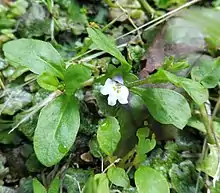Mazus pumilus
Mazus pumilus, commonly called Japanese mazus,[1] is a species of flowering plant in the Mazaceae family. It is native to south and east Asia, where it is found in Bhutan, China, India, Indonesia, Japan, Korea, Nepal, New Guinea, the Philippines, Russia, Taiwan, Thailand, and Vietnam.[2] It is an invasive species in North America.[1]
| Mazus pumilus | |
|---|---|
 | |
| Scientific classification | |
| Kingdom: | Plantae |
| Clade: | Tracheophytes |
| Clade: | Angiosperms |
| Clade: | Eudicots |
| Clade: | Asterids |
| Order: | Lamiales |
| Family: | Mazaceae |
| Genus: | Mazus |
| Species: | M. pumilus |
| Binomial name | |
| Mazus pumilus | |
Its natural habitat is wet grasslands, streambanks, and trailsides.[2] It is tolerant of disturbance, and can be found in areas such as cultivated fields, sidewalk cracks, and waste ground.[2][3] It is a very common species in Japan.[4]
It is an upright annual growing to 30 cm tall. Its flowers are purple and white with yellow spots on the throat. Flowers are produced throughout the growing season.[2]
References
- "Mazus pumilus". Natural Resources Conservation Service PLANTS Database. USDA. Retrieved 6 September 2018.
- Mazus pumilus Flora of China
- Mazus pumilus (in Japanese), Okayama University Plant Ecology Laboratory
- Ohwi, Jisaburo (1965). Flora of Japan. Smithsonian Institution. p. 795.
This article is issued from Wikipedia. The text is licensed under Creative Commons - Attribution - Sharealike. Additional terms may apply for the media files.